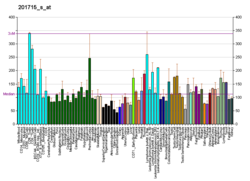Genes on human chromosome 14Human proteinsHuman chromosome 14 gene stubs
2298556215ENSG00000100813ENSMUSG00000022185Q9UKV3Q9JIX8proteinhumansgene
‹ The template Infobox gene is being considered for merging. ›
| ACIN1 |
|---|
|
| Identifiers |
|---|
| Aliases |
ACIN1, ACINUS, ACN, fSAP152, apoptotic chromatin condensation inducer 1 |
|---|
| External IDs |
MGI: 1891824 HomoloGene: 22853 GeneCards: ACIN1 |
|---|
| Gene location (Human) |
|---|
 | | Chr. |
Chromosome 14 (human)[1] |
|---|
| | Band |
14q11.2 |
Start |
23,058,564 bp[1] |
|---|
| End |
23,095,614 bp[1] |
|---|
|
| Gene location (Mouse) |
|---|
 | | Chr. |
Chromosome 14 (mouse)[2] |
|---|
| | Band |
14|14 C2 |
Start |
54,642,161 bp[2] |
|---|
| End |
54,686,931 bp[2] |
|---|
|
RNA expression pattern |
|---|
 | | More reference expression data |
|
| Gene ontology |
|---|
| Molecular function |
• ATPase activity
• protein binding
• enzyme binding
• nucleic acid binding
• RNA binding
|
|---|
| Cellular component |
• nuclear speck
• plasma membrane
• exon-exon junction complex
• nucleoplasm
• nucleolus
• ASAP complex
• cell nucleus
• cytosol
|
|---|
| Biological process |
• apoptotic chromosome condensation
• mRNA processing
• negative regulation of mRNA splicing, via spliceosome
• RNA splicing
• positive regulation of apoptotic process
• positive regulation of monocyte differentiation
• erythrocyte differentiation
• apoptotic process
• execution phase of apoptosis
|
|---|
Sources:Amigo / QuickGO
|
|
| Orthologs |
|---|
| Species |
Human |
Mouse |
|---|
| Entrez |
|
|
|---|
| Ensembl |
|
|
|---|
| UniProt |
|
|
|---|
| RefSeq (mRNA) |
|
|---|
NM_001164814
NM_001164815
NM_001164816
NM_001164817
NM_014977 |
|
NM_001085472
NM_001085473
NM_001242605
NM_001242606
NM_019567
|
|---|
NM_023190 |
|
|---|
| RefSeq (protein) |
|
|---|
NP_001158286
NP_001158287
NP_001158288
NP_001158289
NP_055792 |
|
NP_001078941
NP_001078942
NP_001229534
NP_001229535
NP_062513
|
|---|
NP_075679 |
|
|---|
| Location (UCSC) |
Chr 14: 23.06 – 23.1 Mb |
Chr 14: 54.64 – 54.69 Mb |
|---|
PubMed search |
[3] |
[4] |
|---|
| Wikidata |
| View/Edit Human |
View/Edit Mouse |
|
Apoptotic chromatin condensation inducer in the nucleus is a protein that in humans is encoded by the ACIN1 gene.[5][6][7]
References
^ abc GRCh38: Ensembl release 89: ENSG00000100813 - Ensembl, May 2017
^ abc GRCm38: Ensembl release 89: ENSMUSG00000022185 - Ensembl, May 2017
^ "Human PubMed Reference:"..mw-parser-output cite.citationfont-style:inherit.mw-parser-output .citation qquotes:"""""""'""'".mw-parser-output .citation .cs1-lock-free abackground:url("//upload.wikimedia.org/wikipedia/commons/thumb/6/65/Lock-green.svg/9px-Lock-green.svg.png")no-repeat;background-position:right .1em center.mw-parser-output .citation .cs1-lock-limited a,.mw-parser-output .citation .cs1-lock-registration abackground:url("//upload.wikimedia.org/wikipedia/commons/thumb/d/d6/Lock-gray-alt-2.svg/9px-Lock-gray-alt-2.svg.png")no-repeat;background-position:right .1em center.mw-parser-output .citation .cs1-lock-subscription abackground:url("//upload.wikimedia.org/wikipedia/commons/thumb/a/aa/Lock-red-alt-2.svg/9px-Lock-red-alt-2.svg.png")no-repeat;background-position:right .1em center.mw-parser-output .cs1-subscription,.mw-parser-output .cs1-registrationcolor:#555.mw-parser-output .cs1-subscription span,.mw-parser-output .cs1-registration spanborder-bottom:1px dotted;cursor:help.mw-parser-output .cs1-ws-icon abackground:url("//upload.wikimedia.org/wikipedia/commons/thumb/4/4c/Wikisource-logo.svg/12px-Wikisource-logo.svg.png")no-repeat;background-position:right .1em center.mw-parser-output code.cs1-codecolor:inherit;background:inherit;border:inherit;padding:inherit.mw-parser-output .cs1-hidden-errordisplay:none;font-size:100%.mw-parser-output .cs1-visible-errorfont-size:100%.mw-parser-output .cs1-maintdisplay:none;color:#33aa33;margin-left:0.3em.mw-parser-output .cs1-subscription,.mw-parser-output .cs1-registration,.mw-parser-output .cs1-formatfont-size:95%.mw-parser-output .cs1-kern-left,.mw-parser-output .cs1-kern-wl-leftpadding-left:0.2em.mw-parser-output .cs1-kern-right,.mw-parser-output .cs1-kern-wl-rightpadding-right:0.2em
^ "Mouse PubMed Reference:".
^ Ishikawa K, Nagase T, Suyama M, Miyajima N, Tanaka A, Kotani H, Nomura N, Ohara O (Dec 1998). "Prediction of the coding sequences of unidentified human genes. X. The complete sequences of 100 new cDNA clones from brain which can code for large proteins in vitro". DNA Res. 5 (3): 169–76. doi:10.1093/dnares/5.3.169. PMID 9734811.
^ Sahara S, Aoto M, Eguchi Y, Imamoto N, Yoneda Y, Tsujimoto Y (Sep 1999). "Acinus is a caspase-3-activated protein required for apoptotic chromatin condensation". Nature. 401 (6749): 168–73. doi:10.1038/43678. PMID 10490026.
^ "Entrez Gene: ACIN1 apoptotic chromatin condensation inducer 1".
External links
- Human ACIN1 genome location and ACIN1 gene details page in the UCSC Genome Browser.
Further reading
.mw-parser-output .refbeginfont-size:90%;margin-bottom:0.5em.mw-parser-output .refbegin-hanging-indents>ullist-style-type:none;margin-left:0.mw-parser-output .refbegin-hanging-indents>ul>li,.mw-parser-output .refbegin-hanging-indents>dl>ddmargin-left:0;padding-left:3.2em;text-indent:-3.2em;list-style:none.mw-parser-output .refbegin-100font-size:100%
Zermati Y, Garrido C, Amsellem S, et al. (2001). "Caspase activation is required for terminal erythroid differentiation". J. Exp. Med. 193 (2): 247–54. doi:10.1084/jem.193.2.247. PMC 2193347. PMID 11208865.
Sordet O, Rébé C, Plenchette S, et al. (2003). "Specific involvement of caspases in the differentiation of monocytes into macrophages". Blood. 100 (13): 4446–53. doi:10.1182/blood-2002-06-1778. PMID 12393560.
Strausberg RL, Feingold EA, Grouse LH, et al. (2003). "Generation and initial analysis of more than 15,000 full-length human and mouse cDNA sequences". Proc. Natl. Acad. Sci. U.S.A. 99 (26): 16899–903. doi:10.1073/pnas.242603899. PMC 139241. PMID 12477932.
Shu H, Chen S, Bi Q, et al. (2004). "Identification of phosphoproteins and their phosphorylation sites in the WEHI-231 B lymphoma cell line". Mol. Cell. Proteomics. 3 (3): 279–86. doi:10.1074/mcp.D300003-MCP200. PMID 14729942.
Beausoleil SA, Jedrychowski M, Schwartz D, et al. (2004). "Large-scale characterization of HeLa cell nuclear phosphoproteins". Proc. Natl. Acad. Sci. U.S.A. 101 (33): 12130–5. doi:10.1073/pnas.0404720101. PMC 514446. PMID 15302935.
Jin J, Smith FD, Stark C, et al. (2004). "Proteomic, functional, and domain-based analysis of in vivo 14-3-3 binding proteins involved in cytoskeletal regulation and cellular organization". Curr. Biol. 14 (16): 1436–50. doi:10.1016/j.cub.2004.07.051. PMID 15324660.
Kim JE, Tannenbaum SR, White FM (2005). "Global phosphoproteome of HT-29 human colon adenocarcinoma cells". J. Proteome Res. 4 (4): 1339–46. doi:10.1021/pr050048h. PMID 16083285.
Hu Y, Yao J, Liu Z, et al. (2005). "Akt phosphorylates acinus and inhibits its proteolytic cleavage, preventing chromatin condensation". EMBO J. 24 (20): 3543–54. doi:10.1038/sj.emboj.7600823. PMC 1276706. PMID 16177823.
Joselin AP, Schulze-Osthoff K, Schwerk C (2006). "Loss of Acinus inhibits oligonucleosomal DNA fragmentation but not chromatin condensation during apoptosis". J. Biol. Chem. 281 (18): 12475–84. doi:10.1074/jbc.M509859200. PMID 16537548.
Beausoleil SA, Villén J, Gerber SA, et al. (2006). "A probability-based approach for high-throughput protein phosphorylation analysis and site localization". Nat. Biotechnol. 24 (10): 1285–92. doi:10.1038/nbt1240. PMID 16964243.
Olsen JV, Blagoev B, Gnad F, et al. (2006). "Global, in vivo, and site-specific phosphorylation dynamics in signaling networks". Cell. 127 (3): 635–48. doi:10.1016/j.cell.2006.09.026. PMID 17081983.
Shu Y, Iijima T, Sun W, et al. (2007). "The ACIN1 gene is hypermethylated in early stage lung adenocarcinoma". Journal of thoracic oncology : official publication of the International Association for the Study of Lung Cancer. 1 (2): 160–7. doi:10.1097/01243894-200602000-00010. PMID 17409846.





